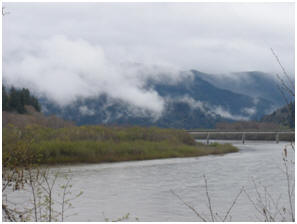Where in the world is Sequoia sempervirens?
The coast redwoods are native to North America, and although the
species has been grown in other areas, it naturally occurs
in only one place in the world: a 724 km (450 mi) strip along
the Pacific Coast of North America.
The strip is about 8 to 56 km (5-35 mi) wide. This strip
begins in southwestern Oregon and extends down the coast, just
south of Monterey in northwestern California. The trees grow
especially well in the mild climate zone, because of the even
temperature and high level of moisture from the winter rains and
summer fog. Recently, redwoods appear to be receding in the southern
part of their range, and expanding to the north.


Though fog is not exactly essential for
redwoods, the forests would be more restricted within their
range without its cooling and dampening properties. These
coastal fogs help to protect the redwoods from drought and heat
during summer. The frequent fogs in summer appear to be more
important than the amount of precipitation to this species of
tree. Fog moderates conditions by dropping temperature and
increasing relative humidity. By absorbing the fog on their
branches, the trees decrease water loss from evaporation and
transpiration. Large redwoods transpire hundreds of gallons of
water vapor into the air through their foliage daily. In
addition, they contribute moisture to the soil in dry periods
during the summer.



Video:
Coast Redwood and the Pacific Coast
Now that you understand where the coast redwood is found, check out Adaptations.
Go back to Classification Information.
Home Sweet Home